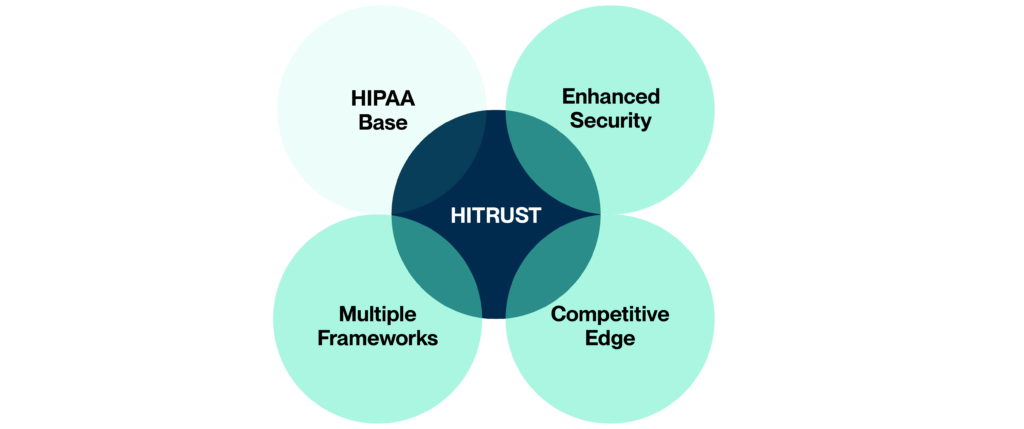The HITRUST framework and HIPAA regulations both play important roles in helping organizations meet their data security, customer privacy, and compliance goals. However, they have notable differences in their nature, scope, and application.
Understanding the Basics: HIPAA vs. HITRUST
Let’s start with HIPAA (the Health Insurance Portability and Accountability Act), a U.S. law enacted in 1996 that established guidelines for protecting patient health information (PHI) and ensuring the privacy and security of electronic health records.
HIPAA consists of five rules that organizations must interpret in the context of their environment, but the legislation does not offer specific implementation guidance.
HITRUST is a certifiable security and privacy framework designed by industry experts to help organizations manage information risk with confidence. It offers a comprehensive, structured approach by integrating multiple standards and authoritative sources, including HIPAA. With clearly defined security controls and requirements, HITRUST simplifies compliance and strengthens data protection across industries.
HIPAA’s Mandatory Requirements
HIPAA is mandatory for covered entities (healthcare providers and insurance companies) and their business associates that handle PHI in the United States. HIPAA compliance is self-assessed, and there is no designated HIPAA certification process nor certification body. Instead, organizations must regularly review their compliance with HIPAA’s Privacy Rule, Security Rule, and Breach Notification Rule in a process that may include engaging third-party auditors.
These assessments generally focus on protecting PHI through administrative, physical, and technical safeguards outlined in the Security Rule. HIPAA also mandates regular risk assessments as part of ongoing compliance efforts but does not prescribe a specific timeline or format for those assessments.
This approach may be best suited for small medical practices or solo practitioners with limited resources. If a covered entity or partner doesn’t need to demonstrate compliance with multiple regulatory frameworks, they may find HIPAA compliance adequate for their needs.
HITRUST’s Broader Reach and Structure
For its part, HITRUST has a broader scope that can be applied to organizations across various industries beyond healthcare. The framework can be used by any organization looking to implement strong security controls based upon real-time threats and demonstrate compliance with multiple standards simultaneously.
HITRUST is more comprehensive, covering over 1,200 requirement statements that can be mapped to over 40 compliance and regulatory frameworks (authoritative sources) across various industries, including HIPAA, CCPA, ISO, NIST, and GDPR.

The HITRUST CSF (Common Security Framework), for instance, comprises of 14 control categories, 49 control objectives and 156 control references that detail specific tasks teams need to perform to achieve those objectives. The requirement statements are spread across the 19 domains that make up the HITRUST CSF.
HITRUST implementation is also more structured, involving a software solution (myCSF) that streamlines audits and assessments. Organizations can become HITRUST-certified by HITRUST, providing a standardized way to demonstrate their compliance and maturity.
HITRUST certification involves a multi-phase process that includes readiness assessments, gap remediation, validation by an external assessor, and a final review and QA by HITRUST itself. Depending on their risk level and assurance needs, organizations can choose from different assessment types.
The Benefits of Choosing HITRUST Over HIPAA
While every healthcare organization has specific requirements, HITRUST certification can offer additional benefits for providers and their business partners than HIPAA compliance alone; given how robust and the coverage organizations implementing the HITRUST framework.

Enhanced Security and Compliance
HITRUST, for instance, provides a more comprehensive and prescriptive approach to security and compliance while also offering greater flexibility. Because the framework’s requirements are tailored to each company’s risk profile and use of PHI, adoption can be scaled up or down to meet individual organizational needs.
With controls are mapped to different security, privacy, and governance standards and frameworks, HITRUST provides a comprehensive approach to meeting multiple compliance requirements simultaneously.
Demonstrated Commitment and Competitive Advantage
HITRUST certification also demonstrates a stronger commitment to data protection. For companies that provide services to covered entities, obtaining HITRUST certification can create competitive advantages over non-certified competitors as more healthcare organizations require HITRUST certification from their vendors.
Overall, HITRUST offers a structured approach with formal certification that demonstrates adherence to multiple regulatory frameworks beyond HIPAA. Organizations seeking higher assurance and broader compliance often opt for HITRUST certification.
While HIPAA is mandatory for healthcare providers and their business partners, HITRUST provides a stronger, more comprehensive security approach. It potentially provides greater value and benefits to organizations in the healthcare industry and beyond.
To learn more about HITRUST and HIPAA compliance, contact us.
















